Pullout Behavior of Nail Reinforcement in Nailed Soil Slope
Abstract
:1. Introduction
2. Materials and Methods for Soil Nail Reinforcement Pullout Test
2.1. Simulation and Dimensional Analysis
2.2. Soil Nailing System
2.3. Testing Box and Loading System
2.4. Nailed Soil Slope Modeling
2.5. Pullout Testing System
- Step 1. Adjust the height of the pulling system according to the position and inclination of the nails;
- Step 2. Attach the nail to the pulling beam by means of wire and locking nut. The load cell is connected to the wire and the pulling beam;
- Step 3. Adjust the pulling speed by means of inverter and Potentiometer to 300 r.p.m, which corresponds to a horizontal speed of 0.282627 mm/min;
- Step 4. Switch on the inverter power and measure the pulling load every two seconds to give a displacement interval of 0.01 mm until the stroke equal to 10 mm or the reading of the load cell become constant with the increasing displacement.
2.6. Finite Element Modeling
3. Results and Discussion
4. Conclusions
- The pullout force was increased as the displacement of the nail increased until it reached the maximum pullout force and then decreased or became constant;
- The lower nail exerted a greater pullout force than the middle nail and the least pull-out force occurred at the upper nail. This may be attributed to the fact that the lower nail had a greater overburden pressure than the middle and the upper nails;
- There was a steep increase in the pullout force in the lower nail with an increase in the footing pressure, whereas in case of the middle nail, there was a slight increase with the increase in footing pressure;
- In the upper nail, the rate of increase of pullout forces changed from a high increase to a constant, whereas in case of the middle nail, the rate of increase of pullout forces increased slowly and became constant;
- The numerical model results point out that the laboratory models underestimate the pullout behavior of nail reinforcement in nailed soil slopes.
Author Contributions
Funding
Institutional Review Board Statement
Informed Consent Statement
Data Availability Statement
Acknowledgments
Conflicts of Interest
References
- Franzen, G.; Jendeby, L. Prediction of Pull-out Capacity of Soil Nails. In Proceedings of the Fifteenth International Conference on Soil Mechanics and Geotechnical Engineering ICSMGE, Istanbul, Turkey, 27–31 August 2001; Volume 2. [Google Scholar]
- Oliaei, M.; Norouzi, B.; Binesh, S.M. Evaluation of soil-nail pullout resistance using mesh-free method. Comput. Geotech. 2019, 116, 103179. [Google Scholar] [CrossRef]
- Panigrahi, R.K.; Dhiman, G. Design and Analysis of Soil Nailing Technique for Remediation of Landslides. Highw. Res. J. 2019, 10, 24–32. [Google Scholar]
- Hu, H.; Lin, P. Analysis of resistance factors for LRFD of soil nail pullout limit state using default FHWA load and resistance models. Mar. Georesources Geotechnol. 2020, 38, 332–348. [Google Scholar] [CrossRef]
- Hong, C.-Y.; Yin, J.-H.; Zhou, W.-H.; Pei, H.-F. Analytical Study on Progressive Pullout Behavior of a Soil Nail. J. Geotech. Geoenviron. Eng. 2012, 138, 500–507. [Google Scholar] [CrossRef]
- Luo, S.Q.; Tan, S.A.; Cheang, W.; Yong, K.Y. Elastoplastic analysis of pull-out resistance of soil nails in dilatant soils. Proc. Inst. Civ. Eng. Ground Improv. 2002, 6, 153–161. [Google Scholar] [CrossRef]
- Su, L.-J.; Yin, J.-H.; Zhou, W.-H. Influence of Overburden Pressure and Soil Dilation on Soil Nail Pull-Out Resistance. Comput. Geotech. 2010, 37, 555–564. [Google Scholar] [CrossRef]
- Hong, C.-Y.; Yin, J.-H.; Pei, H.-F.; Zhou, W.-H. Experimental Study on the Pullout Resistance of Pressure-Grouted Soil Nails in the Field. Can. Geotech. J. 2013, 50, 693–704. [Google Scholar] [CrossRef]
- Cheuk, C.Y.; Ng, C.W.W.; Sun, H.W. Numerical Experiments of Soil Nails in Loose Fill Slopes Subjected to Rainfall Infiltration Effects. Comput. Geotech. 2005, 32, 290–303. [Google Scholar] [CrossRef]
- Pradhan, B.; Tham, L.G.; Yue, Z.Q.; Junaideen, S.M.; Lee, C.F. Soil–Nail Pullout Interaction in Loose Fill Materials. Int. J. Geomech. 2006, 6, 238–247. [Google Scholar] [CrossRef]
- Chen, C.; Zhang, G.; Zornberg, J.G.; Zheng, X. Element Nail Pullout Tests for Prediction of Soil Nail Pullout Resistance in Expansive Clays. Geotech. Test. J. 2019, 42, 1274–1297. [Google Scholar] [CrossRef]
- Ye, X.; Wang, S.; Wang, Q.; Sloan, S.W.; Sheng, D. Numerical and experimental studies of the mechanical behaviour for compaction grouted soil nails in sandy soil. Comput. Geotech. 2017, 90, 202–214. [Google Scholar] [CrossRef]
- Lin, P.; Liu, J. Evaluation and calibration of ultimate bond strength models for soil nails using maximum likelihood method. Acta Geotech. 2020, 15, 1993–2015. [Google Scholar] [CrossRef]
- Li, L.-H.; Chen, Y.-J.; Ferreira, P.M.V.; Liu, Y.; Xiao, H.-L. Experimental Investigations on the Pull-Out Behavior of Tire Strips Reinforced Sands. Materials 2017, 10, 707. [Google Scholar]
- Moayed, R.Z.; Namae, A. Evaluation of the Pullout Resistance of Soil Nails in Tehran Alluvium by Considering the Overburden Pressure Effect. Geotech. Geol. Eng. 2020, 38, 743–754. [Google Scholar] [CrossRef]
- Luo, S.Q.; Tan, S.A.; Yong, K.Y. Pull-Out Resistance Mechanism of a Soil Nail Reinforcement in Dilative Soils. Soils Found. 2000, 40, 47–56. [Google Scholar] [CrossRef] [Green Version]
- Zhou, W.-H.; Yin, J.-H.; Hong, C.-Y. Finite Element Modelling of Pullout Testing on a Soil Nail in a Pullout Box under Different Overburden and Grouting Pressures. Can. Geotech. J. 2011, 48, 557–567. [Google Scholar] [CrossRef]
- Tokhi, H.; Ren, G.; Li, J. Laboratory study of a new screw nail and its interaction in sand. Comput. Geotech. 2016, 78, 144–154. [Google Scholar] [CrossRef]
- Ruggeri, P.; Fruzzetti, V.M.E.; Scarpelli, G. The Behavior of a Thread-Bar Grouted Anchor in Soils from Local Strain Monitoring. Appl. Sci. 2020, 10, 7194. [Google Scholar] [CrossRef]
- Sharma, P.; Rawat, S.; Gupta, A.K. Laboratory investigation of pullout behavior of hollow and solid shaft helical nail in frictional soil. Acta Geotech. 2021, 16, 1205–1230. [Google Scholar] [CrossRef]
- Ehrlich, M.; da Rosa, C.A.B.; Mirmoradi, S.H. Effect of construction and design factors on the behaviour of nailed-soil structures. Proc. Inst. Civ. Eng. Geotech. Eng. 2021, 1–13. [Google Scholar] [CrossRef]
- Chen, C.; Zhu, S.; Zhang, G.; Mao, F.; Cai, H. Time-dependent load transfer behavior of grouted anchors in laterite. Comput. Geotech. 2021, 132, 103969. [Google Scholar] [CrossRef]
- Mohamed, M.H.; Ahmed, M.; Mallick, J.; Hoa, P.V. An Experimental Study of a Nailed Soil Slope: Effects of Surcharge Loading and Nails Characteristics. Appl. Sci. 2021, 11, 4842. [Google Scholar] [CrossRef]
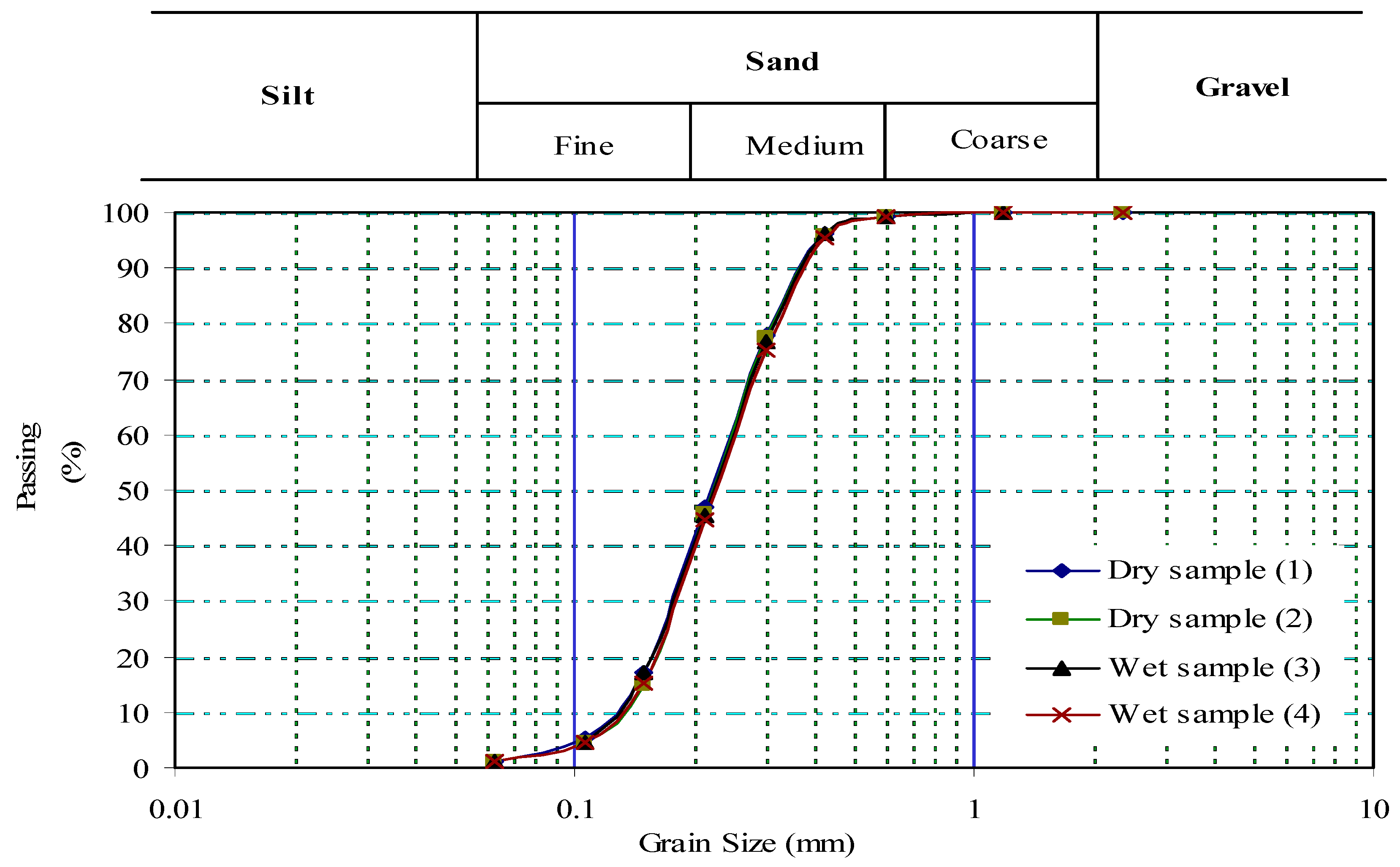



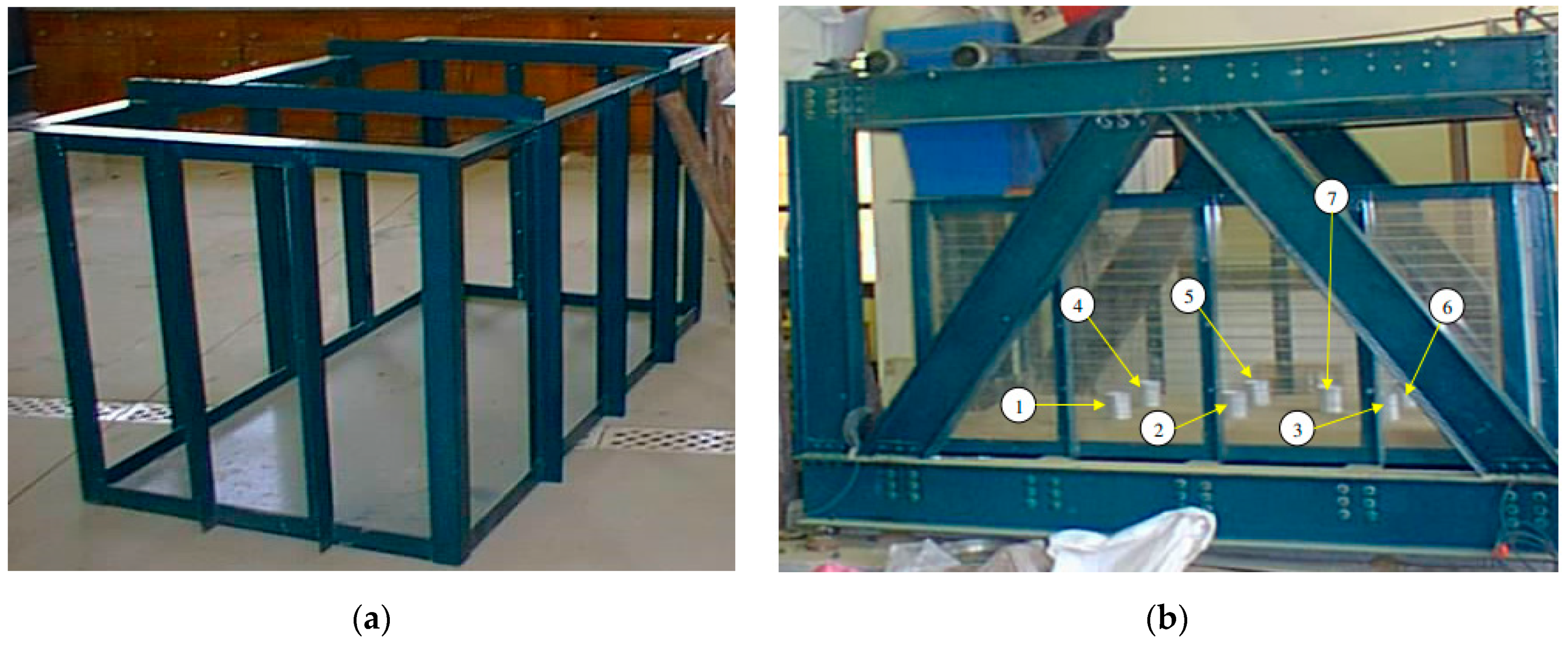

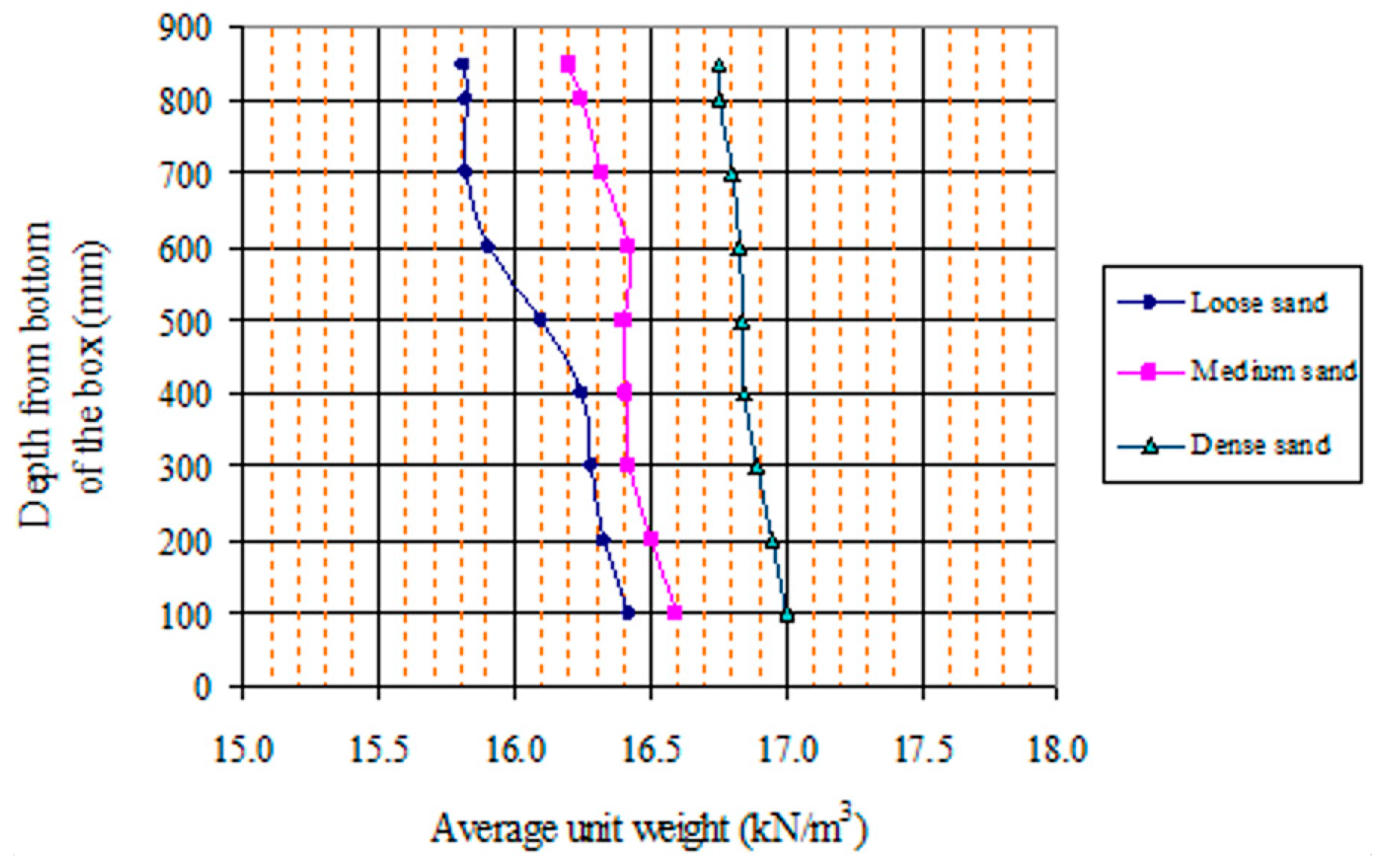



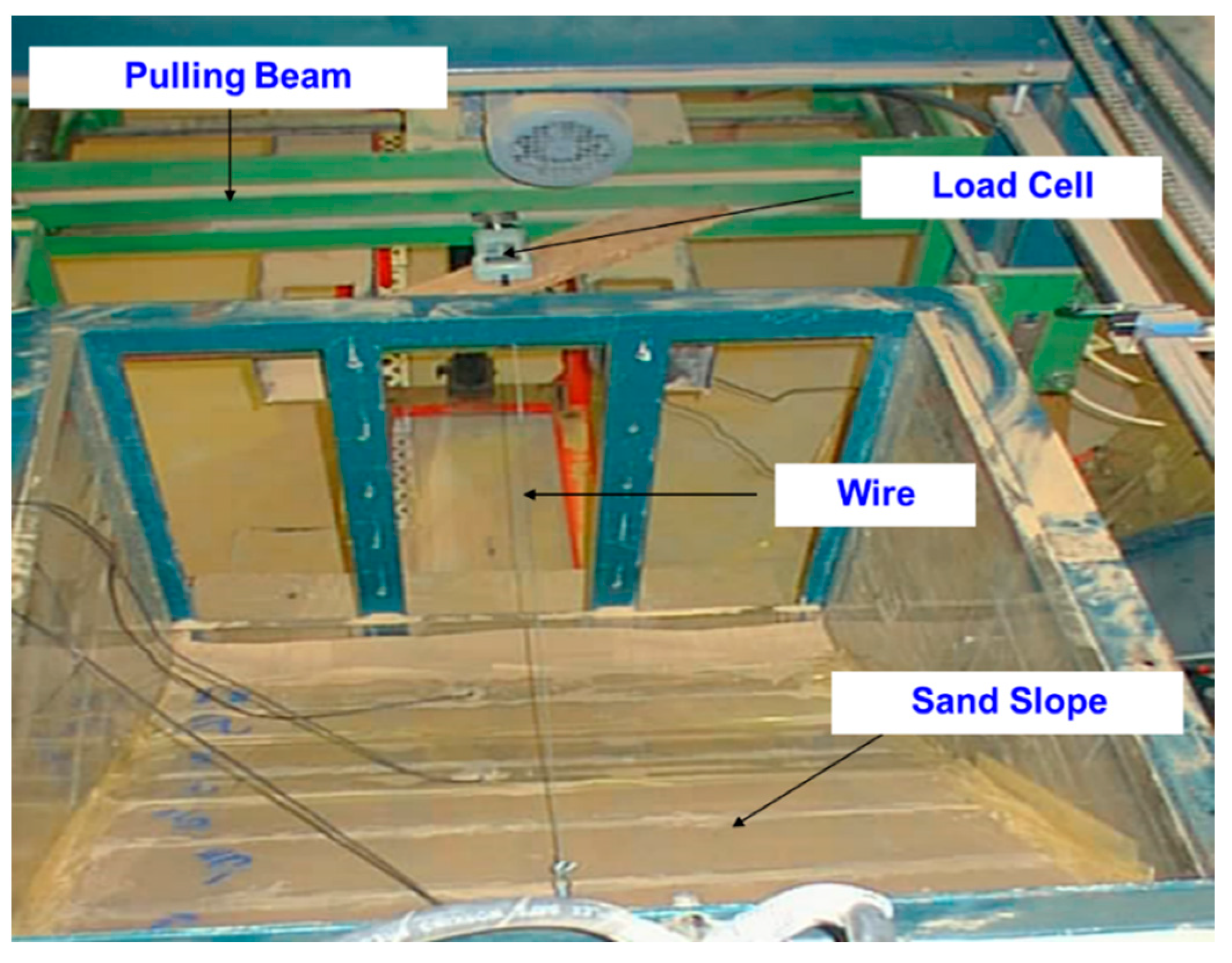

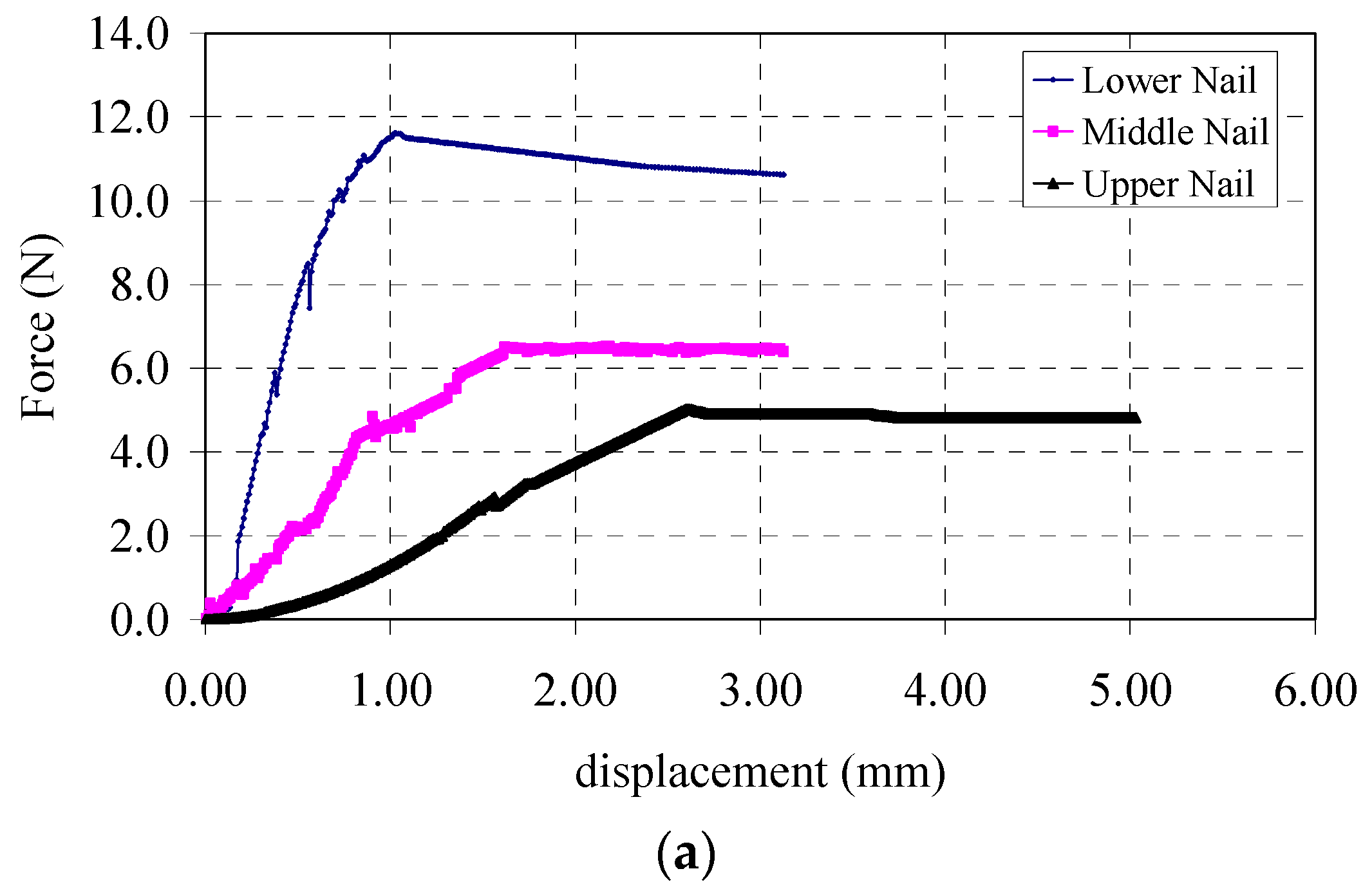

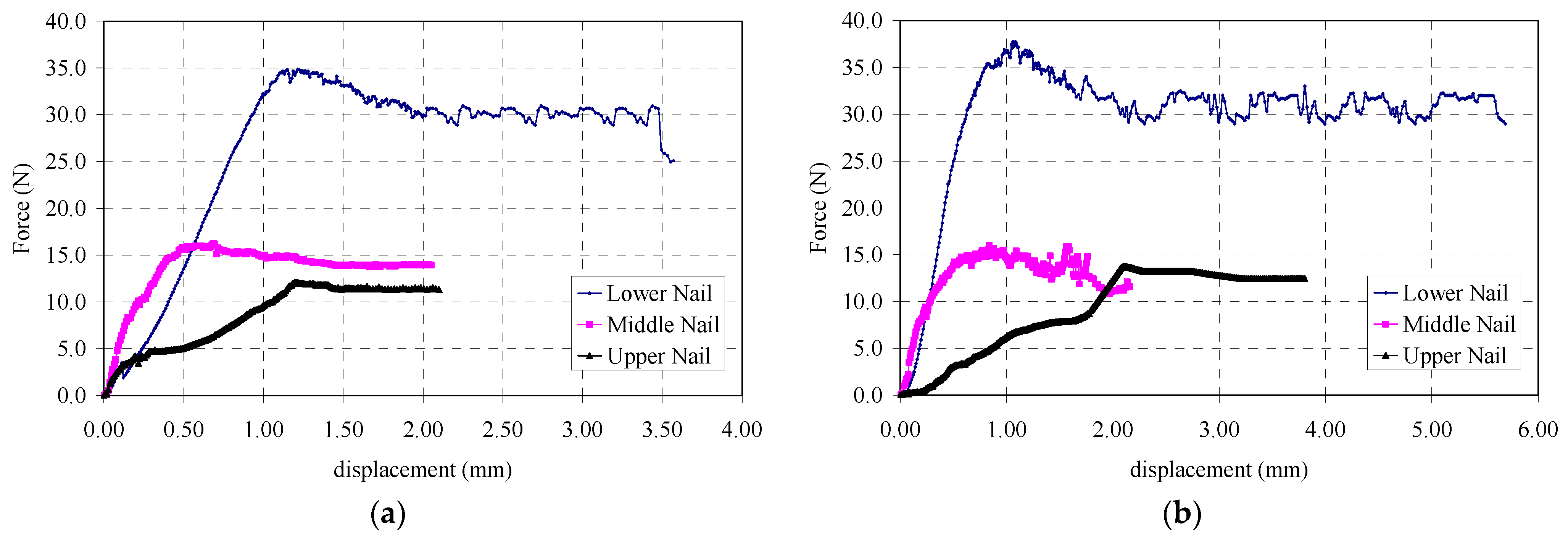
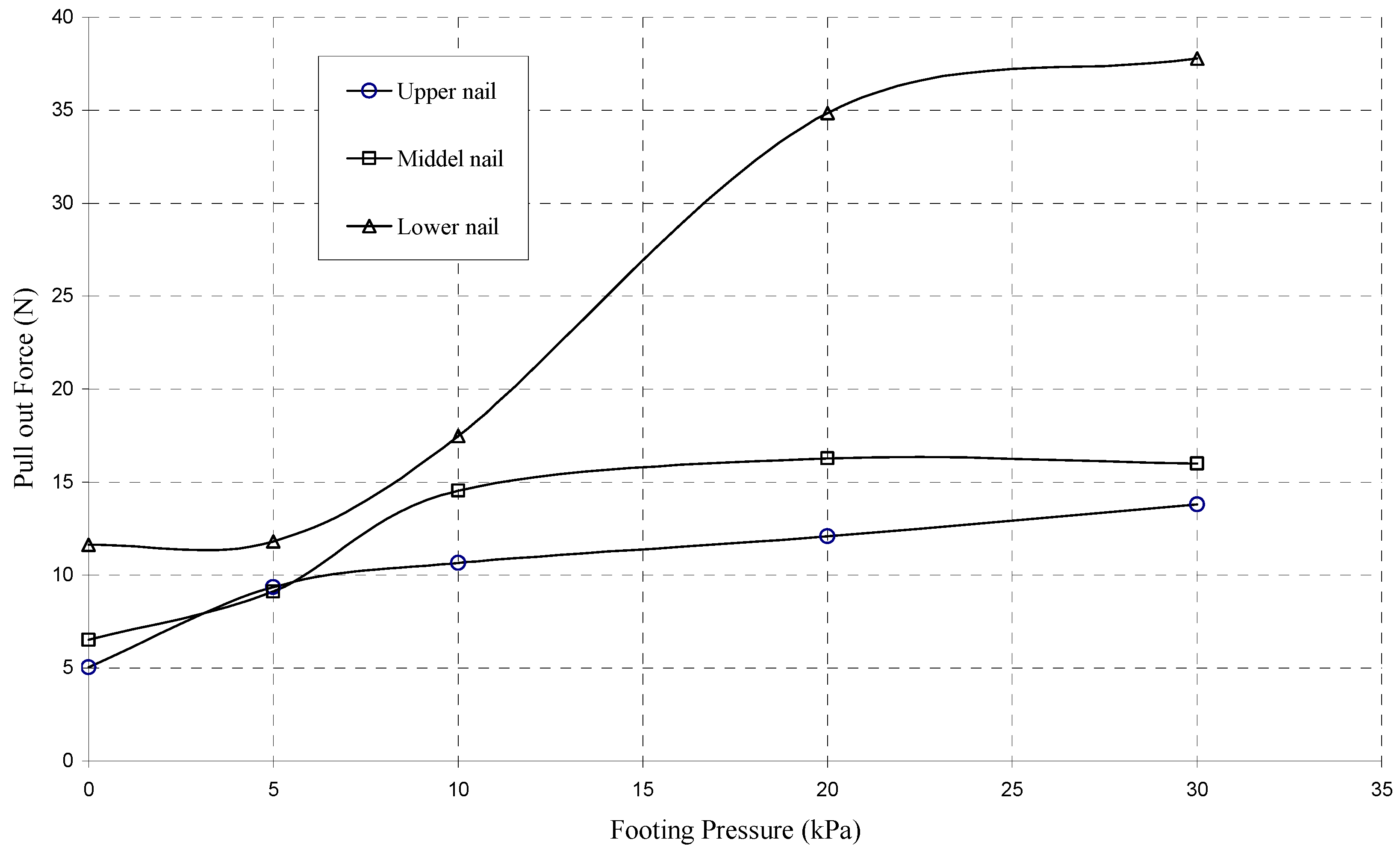





| Property | Value | Property | Value |
|---|---|---|---|
| % of Clay | 0.00 | Specific gravity (Gs) | 2.62 |
| % of Silt | 1.33 | Minimum density (γmin) (kN/m3) | 15.30 |
| % of fine Sand | 39.17 | Maximum density (γmax) (kN/m3) | 17.80 |
| % of medium Sand | 58.63 | Minimum void ratio (emin) | 0.472 |
| % of coarse Sand | 0.87 | Maximum void ratio (emax) | 0.712 |
| % of fine Gravel | 0.00 | Angel of internal friction (ϕ°) | 34 |
| Effective diameter (D10) mm | 0.126 | Bulk Density (γb) (kN/m3) | 16.41 |
| Coefficient of uniformity (Cu) | 1.99 | Void ratio (e) | 0.597 |
| Coefficient of gradation (Cu) | 1.00 | Relative density (%) | 48 |
| Element | Length (mm) | Maximum Tensile Force (kN) | Strains at Ultimate Stress (με) | Maximum Tensile Strength (kPa) | Young’s Modulus (kPa) | Flexural Rigidity, EI (kN·mm2) | Normal Stiffness, EA (kN/m) |
|---|---|---|---|---|---|---|---|
| 5 mm Steel Nails | 700 | 17.4 | 7625 | 8.8 × 105 | 21.2 × 107 | 6.51 × 10−3 | 4165.9 |
| Component | Material | Width (mm) | Thickness (mm) | Young’s Modulus (kPa) | Bending Stiffness (kN·mm2) | Axial Stiffness (kN) |
|---|---|---|---|---|---|---|
| Facing | Perspex | 140 | 5.0 | 4200 | 0.04375 | 0.021 |
| Footing | Steel | 150 | 22.0 | 21.2 × 107 | 188186.6 | 4665.78 |
| Parameter | A (mm) | B (mm) | Y (mm) | Z (mm) | X (mm) | Sh = Sv (mm) | Slope Angle (°) | Nail Inclination (°) | H = Ln (mm) | RD (%) | q (kPa) |
|---|---|---|---|---|---|---|---|---|---|---|---|
| Value | 405 | 150 | 834 | 146 | 225 | 280 | 40 | 0 | 700 | 48 | 5, 10, 20, 30 |
| Bulk Density (kN/m3) | Material Model (Mohr-Coulomb) | Plastic Straining Due to Deviator Loading (E50)ref (kPa) | Plastic Straining Due to Primary Comp. (Eoed)ref (kPa) | Elastic Unloading/Reloading | Stress Dependent Stiffness (m) | ||||
|---|---|---|---|---|---|---|---|---|---|
| φ | C (kPa) | ψ | υ | (Eur)ref (kPa) | υur | ||||
| 16.41 | 34 | 0.2 | 4 | 0.31 | 1959 | 1959 | 5877 | 0.2 | 0.5 |
| Footing pressure (kPa) | 0 | 5 | 10 | 20 | 30 |
| Footing settlement (Lab., %) | 0 | 0.29 | 0.46 | 0.8 | 1.45 |
| Footing settlement (Comp., %) | 0 | 0.265 | 0.5 | 1.13 | 1.95 |
Publisher’s Note: MDPI stays neutral with regard to jurisdictional claims in published maps and institutional affiliations. |
© 2021 by the authors. Licensee MDPI, Basel, Switzerland. This article is an open access article distributed under the terms and conditions of the Creative Commons Attribution (CC BY) license (https://creativecommons.org/licenses/by/4.0/).
Share and Cite
Mohamed, M.H.; Ahmed, M.; Mallick, J. Pullout Behavior of Nail Reinforcement in Nailed Soil Slope. Appl. Sci. 2021, 11, 6419. https://doi.org/10.3390/app11146419
Mohamed MH, Ahmed M, Mallick J. Pullout Behavior of Nail Reinforcement in Nailed Soil Slope. Applied Sciences. 2021; 11(14):6419. https://doi.org/10.3390/app11146419
Chicago/Turabian StyleMohamed, Mahmoud H., Mohd Ahmed, and Javed Mallick. 2021. "Pullout Behavior of Nail Reinforcement in Nailed Soil Slope" Applied Sciences 11, no. 14: 6419. https://doi.org/10.3390/app11146419
APA StyleMohamed, M. H., Ahmed, M., & Mallick, J. (2021). Pullout Behavior of Nail Reinforcement in Nailed Soil Slope. Applied Sciences, 11(14), 6419. https://doi.org/10.3390/app11146419






